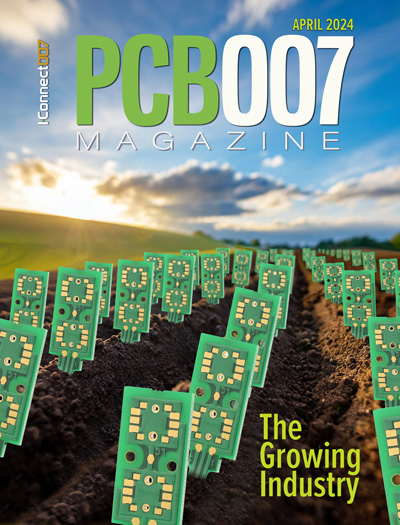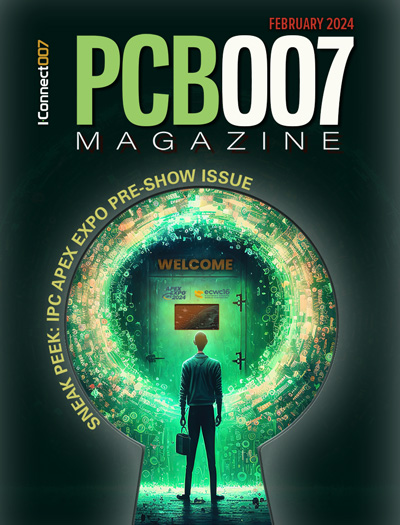-

- News
- Books
Featured Books
- pcb007 Magazine
Latest Issues
Current Issue
The Growing Industry
In this issue of PCB007 Magazine, we talk with leading economic experts, advocacy specialists in Washington, D.C., and PCB company leadership to get a well-rounded picture of what’s happening in the industry today. Don’t miss it.

The Sustainability Issue
Sustainability is one of the most widely used terms in business today, especially for electronics and manufacturing but what does it mean to you? We explore the environmental, business, and economic impacts.

The Fabricator’s Guide to IPC APEX EXPO
This issue previews many of the important events taking place at this year's show and highlights some changes and opportunities. So, buckle up. We are counting down to IPC APEX EXPO 2024.
- Articles
- Columns
Search Console
- Links
- Events
||| MENU - pcb007 Magazine
The Smart Factory: All the Bits and Bobs
March 26, 2020 | Happy Holden, I-Connect007Estimated reading time: 1 minute
“Smart factory” is another phrase that describes Industry 4.0 programs. These programs seem to have replaced CIM and CAM, but it did not make them obsolete. While these topics are getting a lot of press, there is nothing new about them. We have been on a journey to automate manufacturing since the mid-‘70s. What has evolved are faster and cheaper computers, and more complex and integrated networking. Meanwhile, the cost of wireless communications has dropped dramatically and labor and materials costs have gone up. These conditions all foster a greater return for automation, with the possibility of lights-out factories with no environmental impact, leading to “lean and green” implementations.
Strategy and Planning
What hasn’t changed over all these years is the need for a strategic plan to achieve a smart factory. While the investment in automation may be straightforward, the investment in integrating all these islands of automation clearly is not. The strategic planning for this integration is the major topic in the smart factory. Networking has advanced so much in the intervening years that it has now become an over-riding element of the new smart factory. These elements were introduced in the free I-Connect007 eBook Automation and Advanced Procedures in PCB Fabrication.
Figure 1 shows the six stages of planning a smart factory. Most of the elements will be your current equipment and any new islands of automation. The arrows are of significance, as they outline the flow of information that will be an important new part of your smart factory.
To read this entire article, which appeared in the February 2020 issue of PCB007 Magazine, click here.
Suggested Items
Scape Technologies Introduces SCAPE CoCreator at Hannover Messe 2024
04/18/2024 | Scape TechnologiesToday's industrial robotics, 3D Vision, and AI are often confined by costs, complexity, and limited accessibility and usability. Scape Technologies is revolutionizing this field by broadening the horizons of what is possible.
Real Time with... IPC APEX EXPO 2024: Integrating Automation into the North American PCB Market
04/18/2024 | Real Time with...IPC APEX EXPODan Beaulieu introduces James Chien from SAA Symtek Automation Asia and Jason Perry from Technica, who are bringing automation to the North American PCB market. They discuss their expertise in automation, equipment sets, and growing opportunities. The focus is on integrating automation into existing shops, considering hardware, software, and flexibility. They also discuss the challenges of modernizing domestic shops and the potential of expanding automation to other markets.
Neura Robotics and OMRON Forge Strategic Alliance to Revolutionize the Manufacturing Industry with Cognitive Robots
04/16/2024 | BUSINESS WIRENeura Robotics, a global pioneer in cognitive robotics, and Omron Robotics and Safety Technologies Inc., a global leader in industrial robotics and automation, are excited to announce their strategic partnership.
Aegis Software and JUKI Extend Reseller Relationship, Marking Over 23 Years of Collaboration
04/11/2024 | Aegis SoftwareAegis Software, a global provider of Manufacturing Execution System (MES) software, announces that JUKI Automation, a world-leading provider of automated assembly products and systems and subsidiary of JUKI Corporation, has renewed their reseller relationship with Aegis Software.
RTX's Pratt & Whitney Announces North American Technology Accelerator
04/10/2024 | RTXPratt & Whitney, an RTX business, announced details of its North American Technology Accelerator (NATA), a commercial and military aftermarket operations center of excellence based in Florida.


